
USS Fairfax (DD-93) was a Wickes-class destroyer in the United States Navy during World War I, later transferred for World War II service first to the Royal Navy as HMS Richmond (G88), a Town-class destroyer, and then to the Soviet Navy as Zhivuchy.

HMS Antelope was a British A-class destroyer, which was completed for the Royal Navy in 1930. Antelope served throughout the Second World War, taking part in the sinking of three enemy submarines and in Operation Torch, the Allied invasion of French North Africa.
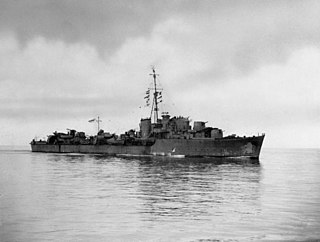
HMS Panther was a P-class destroyer built for the Royal Navy during the Second World War. After commissioning on 12 December 1941, she made a short trip to Iceland with the battleship King George V, then escorted a British convoy to India. In early April 1942, Panther rescued survivors from two cruisers sunk in the Indian Ocean, after which she took part in Operation Ironclad, the Allied invasion of Vichy French-held Madagascar, and sank a French submarine with another destroyer. Panther then returned to the Mediterranean, and participated in the Allied landings in North Africa, but was severely damaged in an air attack and had to undergo repairs in Gibraltar. After taking on survivors from the torpedoed SS Strathallan, Panther escorted two Allied convoys in the Atlantic. She next supported the Allied attack on Sicily, then sailed to the Aegean Sea in the Dodecanese Campaign. On 9 October 1943, Panther was sunk by German Stuka dive-bombers with 33 dead.

HMS Punjabi was a Tribal-class destroyer of the Royal Navy that saw service in the Second World War, being sunk in a collision with the battleship King George V. She has been the only ship of the Royal Navy to bear the name "Punjabi" which, in common with the other ships of the Tribal class, was named after various ethnic groups of the world, mainly those of the British Empire.

Convoy PQ 18 was an Arctic convoy of forty Allied freighters from Scotland and Iceland to Arkhangelsk in the Soviet Union in the war against Nazi Germany. The convoy departed Loch Ewe, Scotland on 2 September 1942, rendezvoused with more ships and escorts at Iceland and arrived at Arkhangelsk on 21 September. An exceptionally large number of escorts was provided by the Royal Navy in Operation EV, including the first escort carrier to accompany an Arctic convoy. Detailed information on German intentions was provided by the code breakers at Bletchley Park and elsewhere, through Ultra signals decrypts and eavesdropping on Luftwaffe wireless communications.

HMS Tartar was a Tribal-class destroyer of the Royal Navy that saw service in most of the naval theatres of World War II. She had an eventful career, eventually receiving the nickname 'Lucky Tartar' due to her numerous escapes from dangerous situations. She was one of only four from the sixteen Royal Navy-operated Tribal-class destroyers to survive the war.
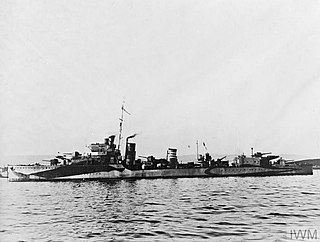
HMS Faulknor was the flotilla leader for the F-class destroyers built for the Royal Navy during the 1930s. The ship had a particularly active operational role during World War II, being awarded 11 battle honours, and was known as "The hardest worked destroyer in the Fleet". She was the first ship to sink a German U-boat, took part in the Norwegian Campaign, served with Force H in the Mediterranean on the Malta Convoys, escorted convoys to Russia and across the Atlantic, and saw action during the invasions of Sicily, Italy and Normandy, and was at the liberation of the Channel Islands. She was then decommissioned and sold for scrap in late 1945.
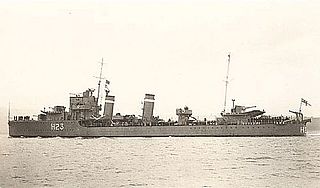
HMS Echo was an E-class destroyer of the British Royal Navy that saw service in the Atlantic, Arctic and Mediterranean theatres during World War II, before being transferred to the Royal Hellenic Navy in 1944, and renamed Navarinon, until scrapped in 1956.

HMS Escapade was an E-class destroyer built for the Royal Navy in the early 1930s. Although assigned to the Home Fleet upon completion in 1934, the ship was attached to the Mediterranean Fleet in 1935–1936 during the Abyssinia Crisis. During the Spanish Civil War of 1936–1939 she spent considerable time in Spanish waters, enforcing the arms blockade imposed by Britain and France on both sides of the conflict. Escapade was assigned to convoy escort and anti-submarine patrol duties in the Western Approaches when World War II began in September 1939, but transferred back to the Home Fleet at the end of the year.

HMS Escort was an E-class destroyer built for the Royal Navy in the early 1930s. Although assigned to the Home Fleet upon completion, the ship was attached to the Mediterranean Fleet in 1935–36, during the Abyssinia Crisis. During the Spanish Civil War of 1936–1939, she spent considerable time in Spanish waters, enforcing the arms blockade imposed by Britain and France on both sides of the conflict. Escort was assigned to convoy escort and anti-submarine patrol duties in the Western Approaches, when World War II began in September 1939. During the Norwegian Campaign, the ship escorted ships of the Home Fleet, although she did tow her sister HMS Eclipse after the latter ship had been badly damaged by German air attack. Escort was assigned to Force H in late June, and participated in the Attack on Mers-el-Kébir in early July. She was torpedoed a few days later by an Italian submarine, but was towed for three days towards Gibraltar before she foundered.

HMS Forester was one of nine F-class destroyers built for the Royal Navy during the early 1930s. Although assigned to the Home Fleet upon completion, the ship was attached to the Mediterranean Fleet in 1935–36 during the Abyssinia Crisis. A few weeks after the start of World War II in September 1939, she helped to sink one German submarine and then participated in the Second Battle of Narvik during the Norwegian Campaign of 1940. Forester was sent to Gibraltar in mid-1940 and formed part of Force H where she participated in the attack on the Vichy French ships at Mers-el-Kébir and the Battle of Dakar between escorting the aircraft carriers of Force H as they flew off aircraft for Malta and covering convoys resupplying and reinforcing the island until late 1941. During this time the ship helped to sink another German submarine.

HMS Fury was an F-class destroyer built for the Royal Navy in the 1930s. Although assigned to the Home Fleet upon completion, the ship was attached to the Mediterranean Fleet in 1935–36 during the Abyssinia Crisis. During the Spanish Civil War of 1936–1939, she spent time in Spanish waters, enforcing the arms blockade imposed by Britain and France on both sides of the conflict. The ship escorted the larger ships of the fleet during the early stages of World War II and played a minor role in the Norwegian Campaign of 1940. Fury was sent to Gibraltar in mid-1940 and formed part of Force H where she participated in the attack on Mers-el-Kébir and the Battle of Dakar. The ship escorted numerous convoys to Malta in 1940–41 and Arctic convoys during 1942.

HMS Laforey was an L-class destroyer of the Royal Navy. She was commissioned in and served during the Second World War, and was torpedoed and sunk by a U-boat in 1944. She had been adopted by the civil community of Northampton in November 1941.

HMS Arrow was an A-class destroyer of the Royal Navy. She served during the Second World War before being damaged while fighting a fire on an ammunition ship and written off in 1943.

HMS Woolston was a W-class destroyer of the Royal Navy. She served through two world wars, surviving both of them.

HMS Opportune was an O-class destroyer of the Royal Navy. She was ordered from John I. Thornycroft & Company, Woolston on 3 September 1939 for the 1st Emergency Flotilla. She was commissioned on 14 August 1942. She was the second Royal Navy ship borne Opportune.

HMS Mahratta was an M-class destroyer of the Royal Navy which served during World War II. Begun as Marksman, she was damaged while under construction, and dismantled to be rebuilt on a new slipway. She was launched as Mahratta in 1942, completed in 1943, and quickly pressed into service. After a short but busy career in the North Atlantic and Arctic, largely guarding merchant convoys, she was torpedoed and sunk on 25 February 1944.
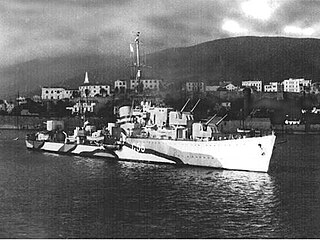
HMS Lightning was an L-class destroyer of the Royal Navy. She was launched on 22 April 1940 and sunk on 12 March 1943 by German Motor Torpedo Boat S-55.

The third HMS Windsor (D42) was a W-class destroyer of the British Royal Navy that saw service in the final months of World War I and in World War II.
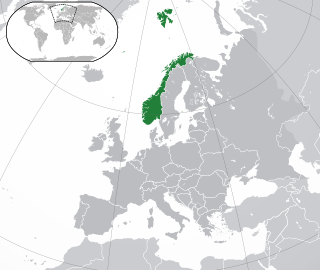
Convoy QP 14 was an Arctic convoy of the QP series which ran during the Second World War. The convoy was a return journey of Allied ships from the port of Archangelsk in the Soviet Union to Loch Ewe in the west of Scotland. The British planned to send Convoy PQ 18 from Iceland to Murmansk and when the convoys crossed transfer much of the escort force from the outbound convoy to Convoy QP 14 and escort back it through the most dangerous waters off Norway.





















